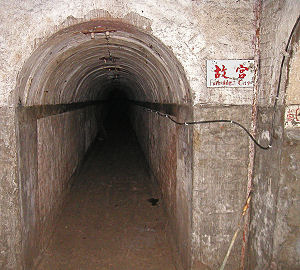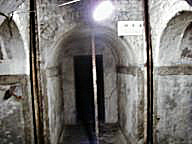Did you know that Beijing has an underground city?

Inconspicuous entrance
Well concealed ...
This is no joke. About 10 meters below street level runs a gigantic network of dark passageways, some allegedly wide enough for 4 trucks abreast. This 85 square kilometers of underworld beneath the center of Beijing allegedly links the central railway station with Qiananmen square, Temple of Heaven, The Forbidden City and the Western hills.
So why don't you see them when visiting Beijing? First because the entrances are located in inconspicuous alleys. And then because the entrances themselves are rather inconspicuous. The only public entrance that I know of is in Xidamochang Jie (photo right), a small alley off Qianmen Dajie a few hundred meters southeast of the southern end of Tian'anmen square.

endless tunnels
Nuclear war ...
Chairman Mao Zedong began the project in 1969 because of the conflict with the former Soviet Union over Zhenbao Island. The underground complex would enable Beijing's entire population to flee from air raids and take China's leaders safely to military bases in the hills. Entrances completed in 1979 are scattered all over Beijing in alleys, backyards and even shop backrooms.

Bath and barber
The undergound complex, officially named Dixia Cheng, was constructed to withstand a nuclear attack as well as 'traditional' air bombardment and even chemical warfare.
This subterranean city is an airraid shelter complete with living quarters, staff headquarter, hospitals, arsenals, toilets, and movie theaters. The original ventilation system and hatches were designed to protect Beijingers from chemical attack and radioactive fallout. Concrete filled steel doors could stop attackers and prevent flooding.
Back in the 1970's Dixia Cheng was fully stocked with food, water, munitions, weapons and medical supplies. Areas were adapted to grow mushrooms and other vegetables that thrive in the dark.

Jessie at a junction
- note the numbering system
A smart numbering system affixed on tunnel junctions helped the citizens orientate themselves as long as they had a regular street map.
Finding your way
Today it all lies empty and virtually disused. Most of Beijing's 12 million citizens have no clue of its existence right under their feet and although officially run by the Tourist Bureau it is almost impossible to locate.

The sign reads "Forbidden City"
-only the daring would venture that way
The passageways on the official tourist route are lit with bare light bulbs. The temperature holds a pleasant 18 degrees celcius year round unaffected by the summer heat and the cold spells of winter. Many openings beckon visitors to wander into pitch-black tunnels.
There are even road signs suggesting where you might wind up but if you lose your way nobody is there to find you, so proceed with caution.
There are no official maps or records to tell how many or which of the original tunnels that are still accessible or how far they extend. Newer constructions and subways have undoubtedly sealed off many passageways so one ventures into the dark at one's own risk.

The larger bricks in the top half
are recycled from the original
Ming Dynasty city wall of the 1420's
Beijing's old city wall rediscovered
Chairman Mao Zedong had Beijing's old city wall torn down to make room for a modern city. But the innumerous bricks from the city wall did not go to waste. In a strange twist of fate they were instead entombed under the city when used as part of the construction of the Underground City!
Workers and even schoolchildren were ordered to dig the many tunnels but it was the army that unbeknownst to the general public added extended lanes for the top leaders' use in case of attack. These latter ones are (probably) inaccessible today.
Allegedly, wide tunnels led from Zhongnanhai, the seat of the government, west of The Forbidden City and all the way to Beijing's Western Hills to allow the leaders to escape quickly by vehicles.
Many of the rooms are now stuffed with old machinery, chairs and other scrap. It is however also welll known that innovative hostel entrepeneurs have opened cheap accomodation for some of the laborers from the provinces seeking jobs in Beijing at price levels far below those of the hotels available at surface level.
The official tour will only take visitors on a small circular stretch but it is enough to give a good impression of the immensity of the project. With a little imagination one can also picture what this would have looked like back in the 1970's. An eerie feeling!

Preparation of silkwom cocoons
Silkworms underground? No way ...
What will take visitors by surprise though is the existence of a working silk factory operating in one of the underground staff meeting rooms. The state owned Qianmen Arts and Crafts Center and the China Kai Tian Silk Co. run a tourist shop and sell high quality silk quilts and other products.
The workers even transform silkworm cocoons on location in the underground staff room. Visitors are treated to a demonstration of the process and might even get the chance to stretch silk cocoons into large, virtually weightless silk sheets used for the manufacture of the quilts.
There are other mementos, outdated propaganda and even a small temple to be seen. At intervals shafts lead up to hatches on the surface and heavy steel doors are inserted designed to prevent access by unwanted intruders.
A mere USD 3 buys all the fun

triple passageway junction
find your own way home
Beijing's Underground City does not form part of the standard tourist sightseeing trip. But for those who enjoy something out of the ordinary and have the time to spare, the Underground City is worth the visit. It is actually mentioned in several tourist pocket guides which is rather fortunate as most Beijingers would not be able to guide you to the entrance. When asked they politely direct you to the nearest subway entrance!
There is a small entrance fee, RMB 20 (approximately USD 3), hardly enough to deter anyone from an exciting excursion into the underworld. Save the ticket as a memento.
I'll leave you with a three-way tunnel split (right). Now find your way out yourself.